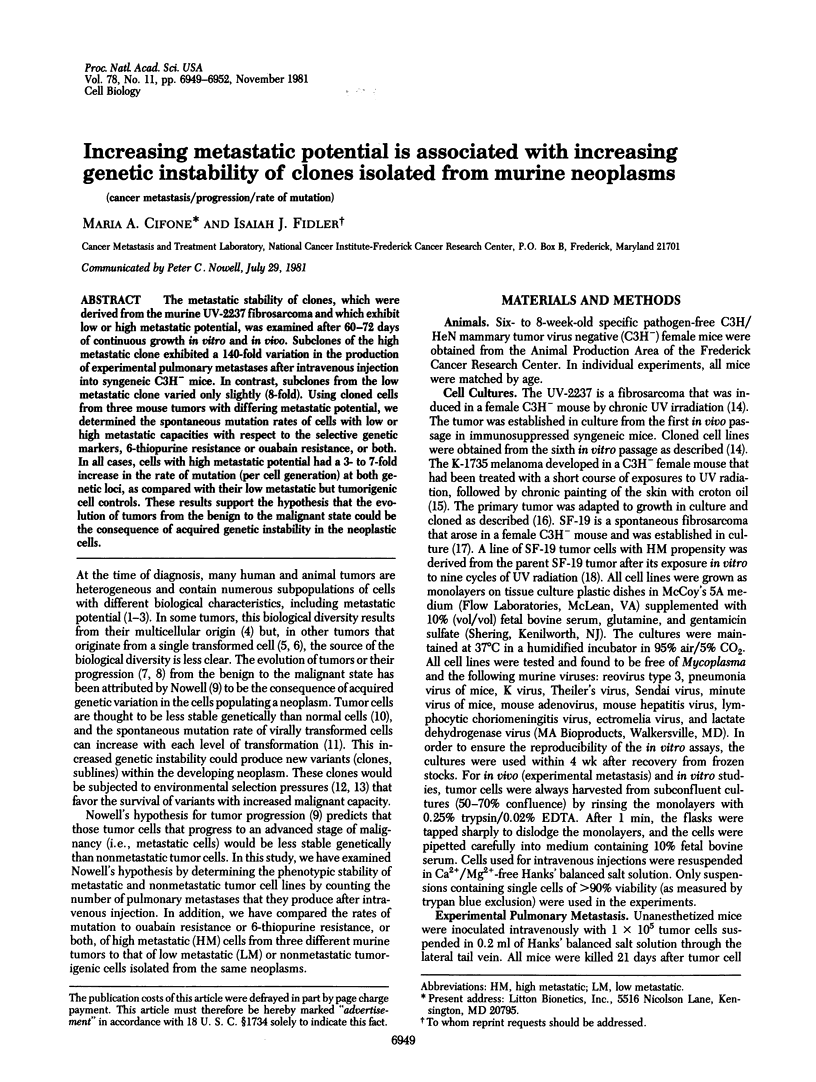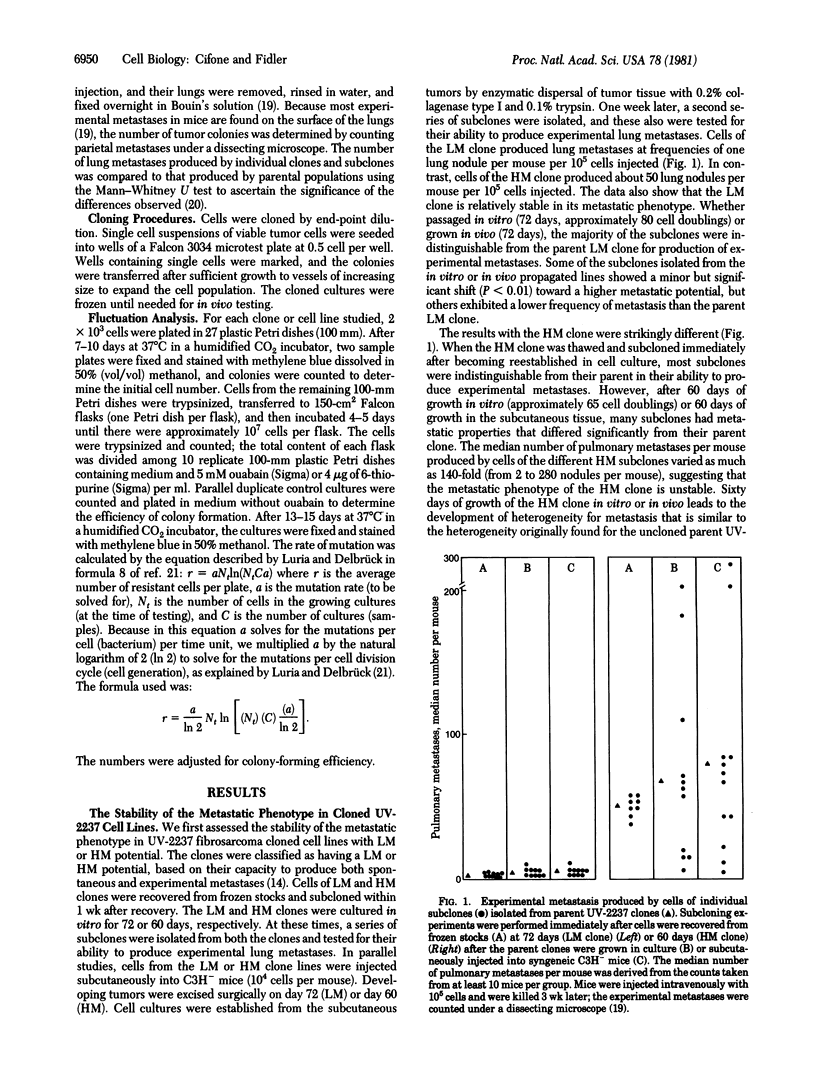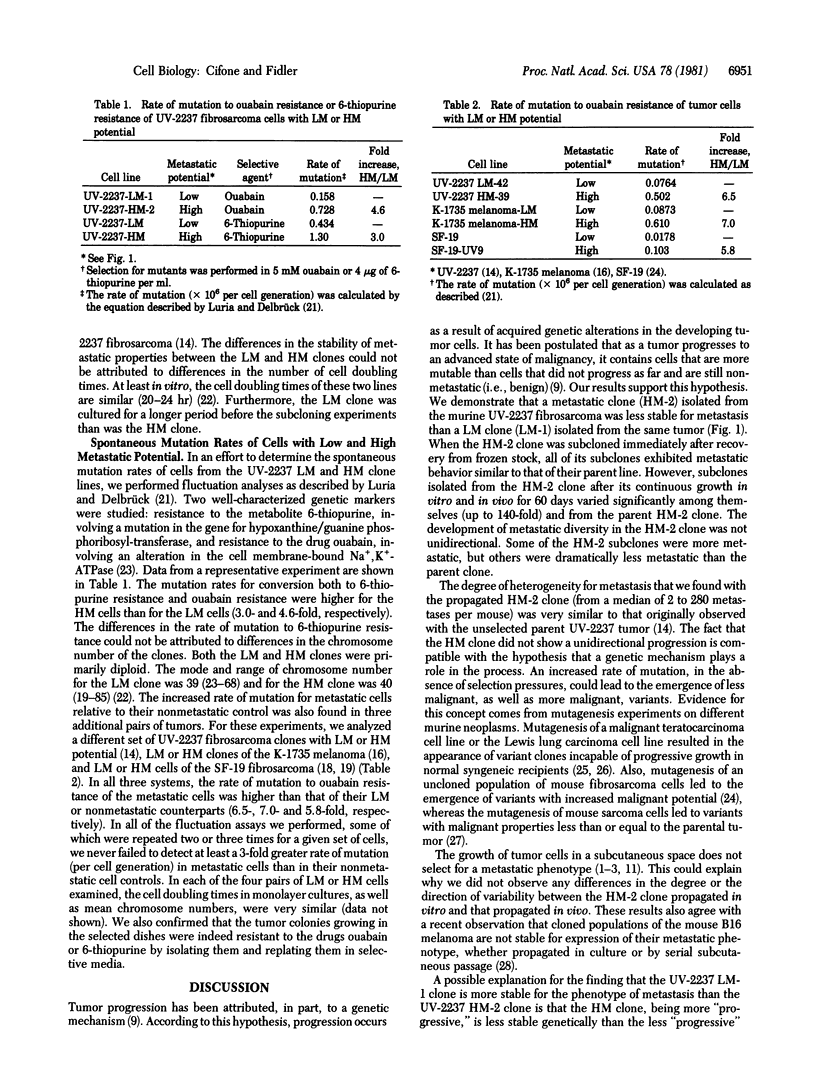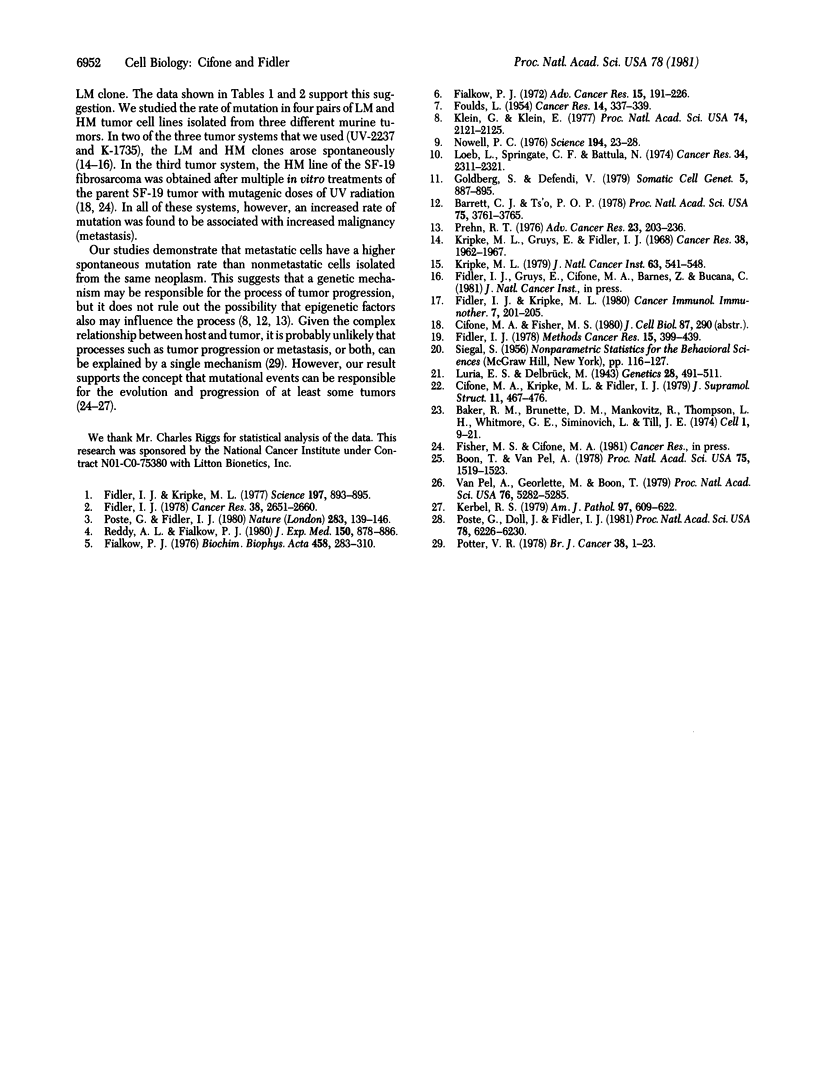Abstract
The metastatic stability of clones, which were derived from the murine UV-2237 fibrosarcoma and which exhibit low or high metastatic potential, was examined after 60-72 days of continuous growth in vitro and in vivo. Subclones of the high metastatic clone exhibited a 140-fold variation in the production of experimental pulmonary metastases after intravenous injection into syngeneic C3H- mice. In contrast, subclones from the low metastatic clone varied only slightly (8-fold). Using cloned cells from three mouse tumors with differing metastatic potential, we determined the spontaneous mutation rates of cells with low or high metastatic capacities with respect to the selective genetic markers, 6-thiopurine resistance or ouabain resistance, or both. In all cases, cells with high metastatic potential had a 3- to 7-fold increase in the rate of mutation (per cell generation) at both genetic loci, as compared with their low metastatic but tumorigenic cell controls. These results support the hypothesis that the evolution of tumors from the benign to the malignant state could be the consequence of acquired genetic instability in the neoplastic cells.
Full text
PDF



Selected References
These references are in PubMed. This may not be the complete list of references from this article.
- Barrett J. C., Ts'o P. O. Evidence for the progressive nature of neoplastic transformation in vitro. Proc Natl Acad Sci U S A. 1978 Aug;75(8):3761–3765. doi: 10.1073/pnas.75.8.3761. [DOI] [PMC free article] [PubMed] [Google Scholar]
- Boon T., Van Pel A. Teratocarcinoma cell variants rejected by syngeneic mice: protection of mice immunized with these variants against other variants and against the original malignant cell line. Proc Natl Acad Sci U S A. 1978 Mar;75(3):1519–1523. doi: 10.1073/pnas.75.3.1519. [DOI] [PMC free article] [PubMed] [Google Scholar]
- Cifone M. A., Kripke M. L., Fidler I. J. Growth rate and chromosome number of tumor cell lines with different metastatic potential. J Supramol Struct. 1979;11(4):467–476. doi: 10.1002/jss.400110405. [DOI] [PubMed] [Google Scholar]
- FOULDS L. The experimental study of tumor progression: a review. Cancer Res. 1954 Jun;14(5):327–339. [PubMed] [Google Scholar]
- Fialkow P. J. Clonal origin of human tumors. Biochim Biophys Acta. 1976 Oct 12;458(3):283–321. doi: 10.1016/0304-419x(76)90003-2. [DOI] [PubMed] [Google Scholar]
- Fialkow P. J. Use of genetic markers to study cellular origin and development of tumors in human females. Adv Cancer Res. 1972;15:191–226. doi: 10.1016/s0065-230x(08)60375-9. [DOI] [PubMed] [Google Scholar]
- Fidler I. J., Kripke M. L. Metastasis results from preexisting variant cells within a malignant tumor. Science. 1977 Aug 26;197(4306):893–895. doi: 10.1126/science.887927. [DOI] [PubMed] [Google Scholar]
- Fidler I. J. Tumor heterogeneity and the biology of cancer invasion and metastasis. Cancer Res. 1978 Sep;38(9):2651–2660. [PubMed] [Google Scholar]
- Goldberg S., Defendi V. Increased mutation rates in doubly viral transformed Chinese hamster cells. Somatic Cell Genet. 1979 Nov;5(6):887–895. doi: 10.1007/BF01542648. [DOI] [PubMed] [Google Scholar]
- Kerbel R. S. Immunologic studies of membrane mutants of a highly metastatic murine tumor. Am J Pathol. 1979 Dec;97(3):609–622. [PMC free article] [PubMed] [Google Scholar]
- Klein G., Klein E. Immune surveillance against virus-induced tumors and nonrejectability of spontaneous tumors: contrasting consequences of host versus tumor evolution. Proc Natl Acad Sci U S A. 1977 May;74(5):2121–2125. doi: 10.1073/pnas.74.5.2121. [DOI] [PMC free article] [PubMed] [Google Scholar]
- Kripke M. L. Speculations on the role of ultraviolet radiation in the development of malignant melanoma. J Natl Cancer Inst. 1979 Sep;63(3):541–548. doi: 10.1093/jnci/63.3.541. [DOI] [PubMed] [Google Scholar]
- Loeb L. A., Springgate C. F., Battula N. Errors in DNA replication as a basis of malignant changes. Cancer Res. 1974 Sep;34(9):2311–2321. [PubMed] [Google Scholar]
- Luria S. E., Delbrück M. Mutations of Bacteria from Virus Sensitivity to Virus Resistance. Genetics. 1943 Nov;28(6):491–511. doi: 10.1093/genetics/28.6.491. [DOI] [PMC free article] [PubMed] [Google Scholar]
- Nowell P. C. The clonal evolution of tumor cell populations. Science. 1976 Oct 1;194(4260):23–28. doi: 10.1126/science.959840. [DOI] [PubMed] [Google Scholar]
- Poste G., Doll J., Fidler I. J. Interactions among clonal subpopulations affect stability of the metastatic phenotype in polyclonal populations of B16 melanoma cells. Proc Natl Acad Sci U S A. 1981 Oct;78(10):6226–6230. doi: 10.1073/pnas.78.10.6226. [DOI] [PMC free article] [PubMed] [Google Scholar]
- Poste G., Fidler I. J. The pathogenesis of cancer metastasis. Nature. 1980 Jan 10;283(5743):139–146. doi: 10.1038/283139a0. [DOI] [PubMed] [Google Scholar]
- Potter V. R. Phenotypic diversity in experimental hepatomas: the concept of partially blocked ontogeny. The 10th Walter Hubert Lecture. Br J Cancer. 1978 Jul;38(1):1–23. doi: 10.1038/bjc.1978.159. [DOI] [PMC free article] [PubMed] [Google Scholar]
- Prehn R. T. Tumor progression and homeostasis. Adv Cancer Res. 1976;23:203–236. doi: 10.1016/s0065-230x(08)60547-3. [DOI] [PubMed] [Google Scholar]
- Reddy A. L., Fialkow P. J. Multicellular origin of fibrosarcomas in mice induced by the chemical carcinogen 3-methylcholanthrene. J Exp Med. 1979 Oct 1;150(4):878–887. doi: 10.1084/jem.150.4.878. [DOI] [PMC free article] [PubMed] [Google Scholar]
- Van Pel A., Georlette M., Boon T. Tumor cell variants obtained by mutagenesis of a Lewis lung carcinoma cell line: immune rejection by syngeneic mice. Proc Natl Acad Sci U S A. 1979 Oct;76(10):5282–5285. doi: 10.1073/pnas.76.10.5282. [DOI] [PMC free article] [PubMed] [Google Scholar]


